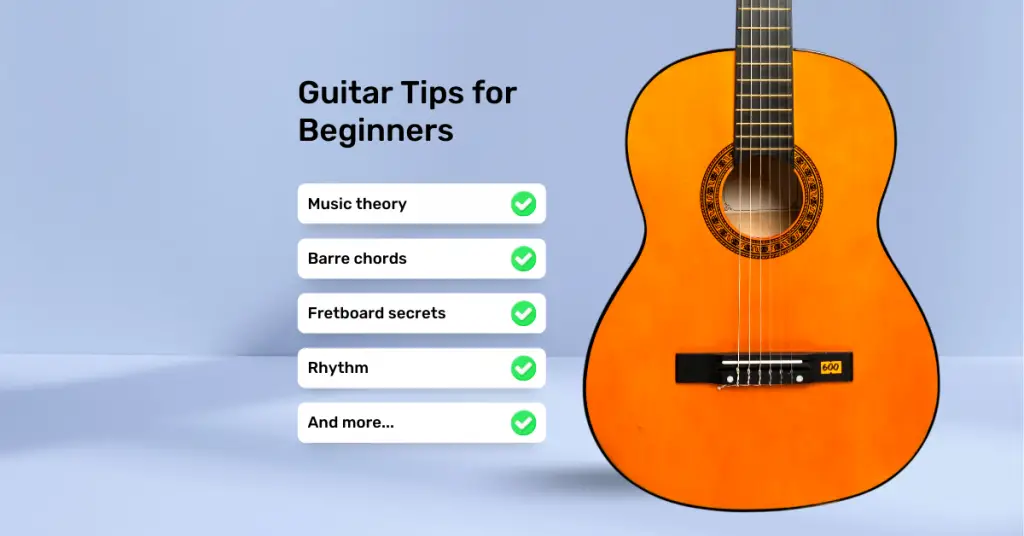One of the first and easiest scales every guitarist needs to learn is the pentatonic scale.
Learning these shapes will open up the guitar fretboard, and make it easier for you to improvise and compose.
Sit back and bust out your guitar as you learn the 5 pentatonic scale shapes for guitar and the theory behind them!
Table of Contents
What is a pentatonic scale?
A pentatonic scale is a 5 note scale.
Penta = 5; Tonic = tones/notes
The major pentatonic scale is derived from the natural major scale (also called Ionian).
The major pentatonic scale you’ll be using is the G major pentatonic scale.
What notes are skipped in a pentatonic scale?
There are two notes skipped in a major scale to get a pentatonic scale. These notes are the fourth (4th) and seventh (7th) degrees of the major scale.
What are the 5 notes in the major pentatonic scale?
The 5 notes in the major pentatonic scale depend on the root note. These 5 notes are determined using the major pentatonic scale formula.
Major pentatonic scale formula
The major pentatonic scale formula is:
1-2-3-5-6
Applying this formula to the root note G gives us the notes G-A-B-D-E.
What are the 5 Pentatonic Scale Shapes?
There are 5 pentatonic scale shapes because there are 5 different notes in the pentatonic scale.
Each shape starts at a different degree of the scale.
You’ll need to pay attention to where the root notes are in each shape to best apply the pentatonic scale.
Each shape will also have a corresponding CAGED shape, which will help you visualize the scale.
This article on arpeggios can also help you understand the application of CAGED shapes.
Pentatonic Shape 1:
The starting note for shape 1 is the 3rd fret of low E, which so happens to be our root note.
Root notes on the E string(s) are easiest to remember because they’re the only guitar string that exists twice, which means you have the root note memorized on 2 strings!

G Major Chord (E Shape)

Pentatonic Shape 2:
Shape 2 starts from the 5th fret of low E.
The root notes are on strings D and B, and clearly represent a D shape.

G Major Chord (D Shape)

Pentatonic Shape 3:
Shape 3 is one of my favorite pentatonic shapes to use because the finger structure flows really well!
The root notes are on strings A and B and represent a C shape.

G Major Chord (C Shape)

Pentatonic Shape 4:
Shape 4 is one of the easiest shape to remember, because the fret numbers are the same on strings low E,A,B, and high E.
Strings D and G have the same fret numbers as well!
Just make sure to remember that the root notes are on strings A and G. Think of them as the top and bottom of a G power chord.
This position outlines and represents an A shape.

G Major Chord (A Shape)

Pentatonic Shape 5:
Pentatonic shape 5 is the most common pentatonic scale shape, and the root notes are on both E strings and the G string.
This shape is most well-known as the first minor pentatonic shape. It becomes this when you look at E as the root note instead of G.
This outlines a G shape and starts at the 12th fret. You can also move this entire shape down to the open position.

G Major Chord (G Shape)

Major Pentatonic Vs. Minor Pentatonic
The major pentatonic scale shapes are the same as the minor pentatonic scales shapes.
The type of pentatonic scale you get is all relative to the root note and the musical context.
You can read more about it in this article:
Difference Between Major and Minor Pentatonic Scales
Summary: Practicing the 5 Pentatonic scale shapes
In summary, playing and learning the 5 pentatonic scale shapes is an important step for understanding and visualizing the fretboard.
Memorize each shape, learn how they connect, and learn where the root notes are in each position.
Start applying the shapes from there. I’d suggest starting with some blues and rock licks.
Thank you for reading! Please leave a comment below if you have any questions.
You can check out my YouTube channel here.
Click on any of these categories to learn more about guitar!
- 7th Chords
- Advanced Guitar
- Blues Guitar
- Buyers Guide
- Extended Range Guitars
- Gear Reviews
- Guitar Arpeggios
- Guitar Book Reviews
- Guitar Chords
- Guitar Exercises
- Guitar for Beginners
- Guitar Gear
- Guitar Licks
- Guitar Modes
- Guitar pedals
- Guitar Picks
- Guitar Scales
- Guitar Songs
- Guitar Tabs
- Guitar Techniques
- Guitar Terms
- Guitar Theory
- Guitar Tunings
- Intermediate Guitar
- Keys
- Major Pentatonic Scales
- Metal Guitar
- Minor Chords
- Minor Keys
- Minor Scales
- Music Career
- Open Guitar Chords
- Pentatonic Scales
- Reviews
- Rock Guitar
- Shred Guitar
- Teacher Marketing
- Uncategorized



